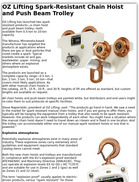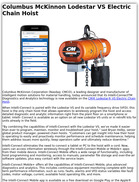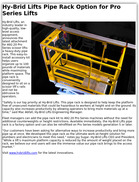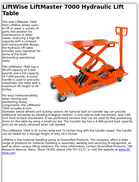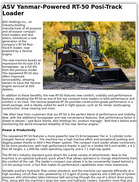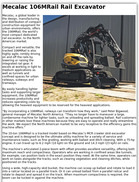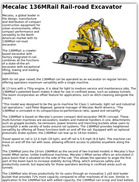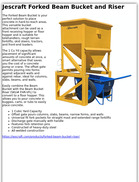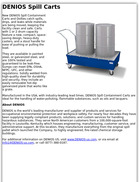Mecalac 106MRail Rail Excavator
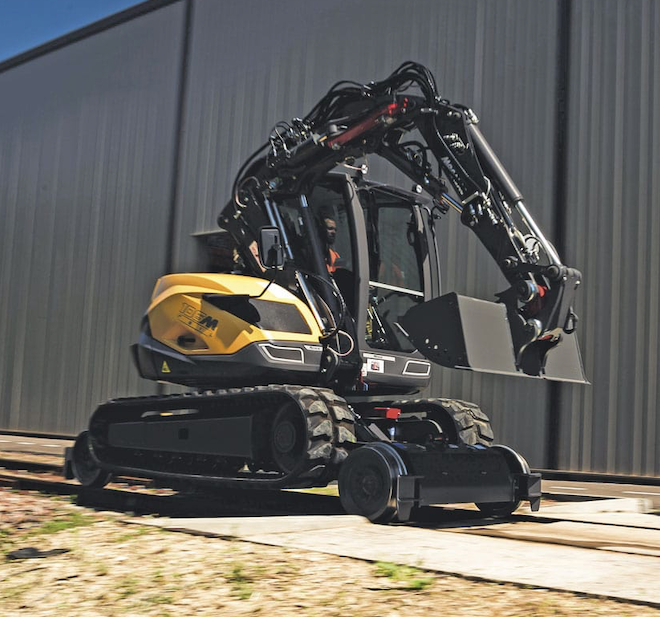 Mecalac, a global leader in the design, manufacturing and distribution of compact construction equipment for urban environments, offers the 106MRail, the world’s most compact dedicated rail excavator, to the North American market.
Mecalac, a global leader in the design, manufacturing and distribution of compact construction equipment for urban environments, offers the 106MRail, the world’s most compact dedicated rail excavator, to the North American market.
Compact and versatile, the tracked 106MRail is also highly agile, nimbly driving on and off the rails by lowering or raising the integrated rail gear. It excels at working in light to medium applications as well as tunnels and confined spaces for urban railways, subways and tramways.
By easily handling lighter tasks and supporting larger equipment, the 106MRail increases productivity and reduces operating costs by allowing the heaviest equipment to be reserved for the heaviest applications.
“By incorporating a 106MRail, railways can transform how they work,” said Peter Bigwood, general manager of Mecalac North America. “They no longer have to maneuver a large, cumbersome machine for lighter tasks, such as unloading and spreading ballast. Rail customers in other markets love these machines because they are easy to operate and really streamline the work. We expect the North American market to be very receptive to the efficiency gains this machine offers.”
The 10-ton 106MRail is a tracked model based on Mecalac’s MCR crawler skid excavator concept and is designed to be the ultimate utility machine for a variety of service and maintenance tasks, such as fine grading, working with ballast and ditch cleaning. With a 75-hp engine, it can travel up to 6.2 mph (10 kph) on the ground and 14.3 mph (23 kph) on rails.
The machine’s articulated 2-piece boom with offset provides excellent versatility, offering both maximum reach and compactness. Operators who are working in confined areas like tunnels, for example, can position tools in the exact position they need. At the same time, operators can work on tasks alongside the tracks, such as clearing vegetation and cleaning ditches, while positioned on the tracks.
Using a wide, high-capacity skid bucket, the machine can scoop up ballast and rotate to load it into a railcar located on a parallel track. Or it can unload ballast from a parallel railcar and rotate to deposit and spread it on the track. When maximum compactness is required, the boom can be tucked in against the machine.
The model can also support larger equipment thanks to its exceptional lifting capacity. When the machine is on the rails, for example, it can reach 7 feet from the center of the machine and lift up to 6,000 pounds with the arm at 90 degrees. Rather than using two large machines, the 106MRail can help a larger machine lift small rail panels, carry sleepers, or move equipment or materials to where they are needed.
To save on fuel, the 106MRail has an engine with automatic low idle. After a pre-set amount of time, the engine will switch to low idle when not in use. To resume engine RPM, the operator simply moves any machine control. This feature significantly reduces fuel consumption and wear on the engine.
“The goal of this machine is to give railways the quality performance and versatility they are searching for in a smaller machine,” says Bigwood. “The 106MRail eliminates the need to run a large machine at a high cost for light applications, allowing railways to optimize their fleets.”
The 106MRail is the smallest rail excavator in the four-model MRail series. The range includes another tracked model, the 13-ton 136MRail, and two-wheeled models, the 156MRail and 216MRail, which are based on the MWR wheeled excavator. The series is designed to meet all railway needs, from maintenance of the railway to new track construction.
Learn more about Mecalac’s MRail-Series at www.mecalac.com.

